Badminton grip is the most basic skill you need to master before playing the game on the court. Most people tend to neglect the details of how to grip a racket. This is actually an essential technique that you need to do correctly if you are serious about playing badminton.
The correctness of the grip is directly related to the technique of the movement, the feel of the hand, and the strength of the final shot. It has a close relationship with mastering and improving the skill level of badminton.
For beginners who are new to badminton, the first thing to master is the proper grip of the racket. I would love to share with you how to master the essentials of the badminton grip quickly.
What Are the Different Grips in Badminton?
There are two types of badminton racket grip, which are the forehand grip and the backhand grip. The following techniques are all based on the right-handed grip.
Forehand Grip
The forehand grip is also called the “handshake” grip.

When you first hold the racket, you should use your left hand to hold the shaft and make the racket face perpendicular to the ground. Then you open the palm of your right hand so that the palm between the thumb and index finger is facing the inside of the racket frame.
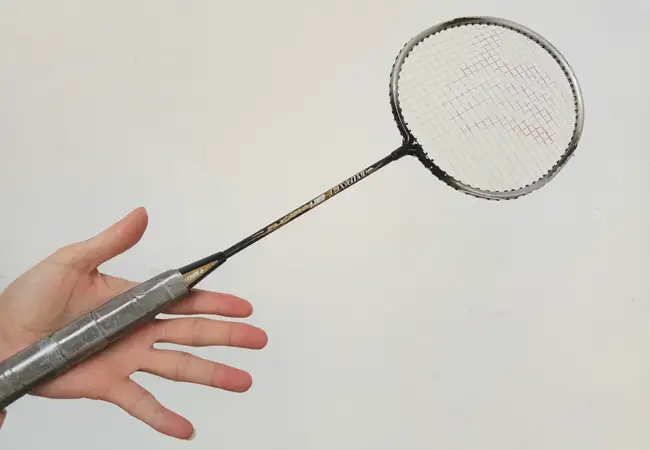
The palm leans on the end of the handle of the racket. Get the little finger, ring finger, and middle finger naturally close together. The index finger and middle finger are slightly separated, and the inside of the thumb and index finger is attached to the handle to hold the racket. Do not stick the handle to the palm of your hand when gripping the racket. It would help if you kept the palm and the handle in a certain gap.
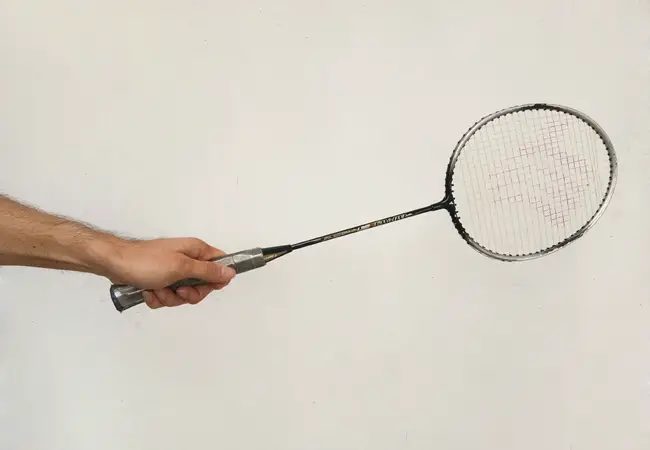
Demonstration
1. Place your right palm firmly on the string bed of your racket.
2. Slowly slide your hand down the shaft towards the racket handle.
3. Grip the racket handle.
Note:
Position the base of your index finger on the flat side of the handle at a slight angle, as if you were about to shake hands with your racket.
Generally, most players will use the forehand grip of their racket when they:
- Serve with their forehand.
- Do the right side shot at the front net.
- Hitting shuttle under the shoulder.
- Hitting shuttle over the shoulder.
- Hitting shuttle over the head.
Backhand Grip
The backhand grip method is based on the forehand grip. The thumb is straightened, and the inner side of the first knuckle is attached to the racket’s handle. The index finger is retracted and is of similar high or slightly higher than the thumb.
Use the thumb and index finger to turn the racket slightly outward. The middle finger, ring finger, and little finger clench the handle. And the end of the handle is close to the root of the little finger.
There should be a gap between the palm and the handle. This is to make full use of the strength of the wrist and the pressure on the inside of the thumb.
When doing a backhand serve, the stroke on the left side of the body and the stroke on the shoulder are generally used in the backhand grip.
Demonstration
1. Position your thumb on the flat (wider) part of the racket handle. Then secure your grip by wrapping your
fingers around the handle.
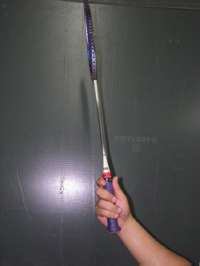
The backhand grip is also sometimes called the “Pan-Handle Grip” as it is similar to the grip used when handling a cooking panhandle.
2. Use your thumb to guide the direction of your racket, and remember to use a whipping motion when executing the backhand.
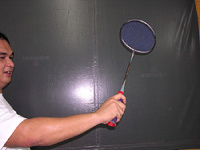
Generally, most players will use the backhand grip of their racket when they:
- Serve with their backhand.
- Do the left side shot at the front net.
- Hitting the shuttle under the shoulder from the left side.
- Hitting shuttle over the shoulder from the left side.
New Backhand Grip
With the development of badminton, the speed has evolved to become faster. The style of play is more advanced, and the technique has become more delicate. Therefore, another type of backhand grip is generated.
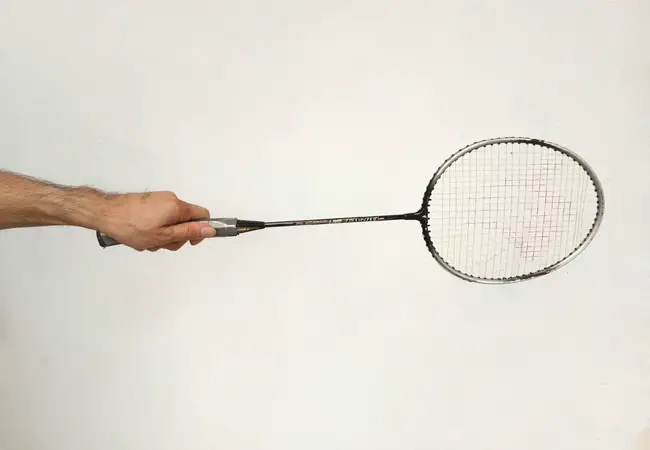
The other type of backhand grip is the inner side of the thumb’s first knuckle is naturally attached to the narrow face of the handle, and the hand has clapped. The palm keeps a certain gap with the handle.
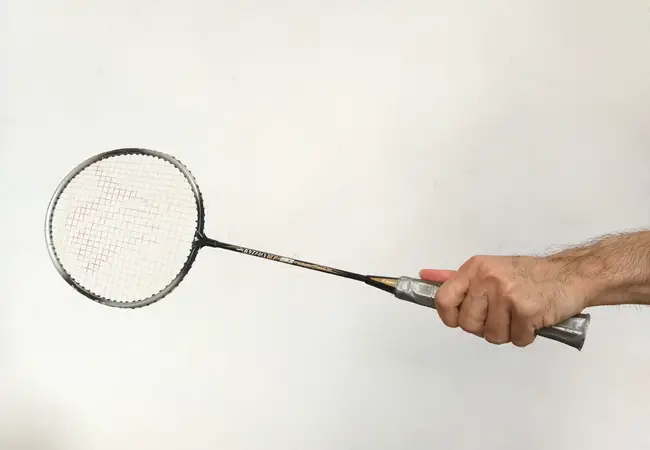
This type of grip can give full play to the strength and flexibility of each finger. When hitting the shuttle, the technical movement is small. The explosive force is strong, the shuttle speed is increased, and you can use the finger strength to control the shuttle to make it drop to a better drop point.
Master the Right Grip
For you to master the proper badminton grip, you must pay attention to the following points:
First: the grip must be agile, loose, and flexible.
Agile – When gripping the racket, holding the racket’s handle too hard is not advisable. By gripping in this way, it will not affect the flexibility of the wrist and finger movement. If the grip is too tight, it is difficult to do a power shot when hitting the shuttle. This can limit the normal function of the technique.
Loose – When gripping the racket, the fingers should naturally separate and hold the racket’s handle. The palm should not be close to the handle, and there should be a gap between the thumb and index finger. It would be best to grip the handle tightly when you want to hit the shuttle with power. This is to avoid the racket get off from your hand.
Flexible – When using different techniques in different positions or angles, you must slightly change how you grip the racket. This is for you to experience a different grip and feel to come out with an appropriate shot. When you grip the racket, you should be good at using the power of your fingers to change to achieve the consistency of technical movements.
Second: Power shot
Power shot is the force that a badminton player uses or emits when hitting the shuttle. It used to be said that when playing badminton, the force of the hand is mainly based on the strength of the arms and wrists.
However, with the development of badminton, the technical movement has become more delicate. The hitting speed is faster, and the power is stronger. The strength of the arm and the wrist alone is difficult to adapt to the changes.
Therefore, it is necessary to use and exert the power of the finger. It would be best if you exerted the combination of power from the wrist and finger to meet the needs of today’s badminton technology development.
The power exerted by the finger is mainly based on the strength of the thumb, index finger, and middle finger, also with the complementary strength from the palm’s left side.
The ring finger and the little finger only play the role of coordinating to exert flexibility and hitting power. They also cooperate in turning the racket to make more power for the player when hitting the shuttle.
Badminton Grip Training
The correct grip is not hard to learn, but it is easy to get out of the way when playing on the court. Most players tend to return to the wrong habitual grip when playing badminton. Therefore, beginners should pay attention to the habit of developing a correct grip and stick to it.
When a player’s skill reaches a certain level, the flexibility of the grip is the key to improving the quality of the shot. If you grip the right way, you can fully exert the explosive power of the wrist and the finger.
With the correct grip, you can achieve the consistency of your playing style before the shot. This can avoid premature exposure of your intention of hitting the shuttle to your opponent.
Also, when you can grip the racket correctly, you will get yourself adapted to the shuttle. You can then be flexible and use a slightly different grip method to play various shots and make endless changes when hitting the shuttle.
- Grip the racket according to the correct grip method and understand the difference between the forehand and the backhand grip.
- Use your fingers to rotate the racket to the left and right continuously. Alternately doing the exercises of the forehand and the backhand grip. Verifying the flexibility and correctness of the forehand and backhand grip.
- Use the forehand and backhand grip methods to do continuous upward batting exercises. Comprehend the movements of the arms, wrists, and fingers. Cultivate the feeling of the shuttle and the eyes watching on the shuttle.
- Use the forehand and backhand grip method to perform the swing according to the technical action essentials such as serving, picking, and hitting the shuttle.
- After mastering the method of correct grip, you can practice the serve and hit the shuttle on the court.
You may be interested in reading this post about someone using a panhandle grip for her badminton play.
Read also:
